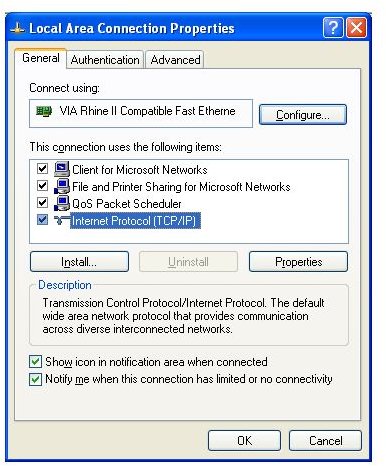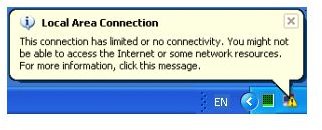Limited or No Connectivity Error Message - How to Troubleshoot & Fix
Why Does This Message Appear?
The limited or no connectivity error message is one of the most irritating error messages you can get when you try to connect to the Internet. If you are using DHCP (Dynamic Host Control Protocol) to connect to the Internet, and you haven’t explicitly disabled notification about limited or no connectivity errors in the settings for your connection, then sooner or later you are likely to experience this message. When your connection has limited or no connectivity, you will get an error message similar to this one: “This connection has limited or no connectivity. You might not be able to access the Internet or some network resources.” Along with this message you will also see a yellow exclamation mark in the taskbar network connection icon:
There are many reasons why you are getting the limited or no connectivity error message and all of them have something to do with the inability to connect to the DHCP server and get an IP (Internet Protocol) address. If you haven’t enabled notifications about limited or no connectivity error messages in the settings for a particular connection, you might not see any error messages but still you won’t be able to browse the Internet. In this case, you might not know why this happens but notification or no notification, the main reasons for getting these error messages are usually for one or more of the following reasons:
- A software you installed has caused the error. Most commonly the software in question is SP2 for XP but there are also other applications, which might interfere with your TCP/IP settings. In some cases it could even be a firewall.
- Incorrect TCP/IP settings. Incorrect TCP/IP settings are also a common reason for the limited or no connectivity error message. The list of possible incorrect settings is endless and I am not going to list all of them. If you can’t fix the TCP/IP settings on your own, ask your network administrator or Internet Service Provider (ISP) provider for help.
- The DHCP server is down or can’t be accessed. If the DHCP server where you get your IP address is not up or is inaccessible, you will also receive the error message. You don’t get a “Network Cable Unplugged” message, but you still have no Internet because you don’t have an IP, so you can’t establish a connection. The reason here could be the router, or your Internet provider – you need to investigate and based on what you discover, apply the appropriate fix.
These three reasons for the limited or no connectivity error message aren’t the only ones but since they are very common, your troubleshooting should start with them. In any case, before you start troubleshooting the problem, you need to know why it occurs.
How to Fix the Error Message
As with any thing technical, the way you fix a problem depends on the reason the problem exists. Here are some popular fixes for the error messages in the previous section:
1. Install a patch. If the limited or no connectivity error message appears after you have installed something (like SP2 for XP or similar), then most likely the stuff you installed is the culprit. You can uninstall it, but this is not a guarantee that things will be fixed. You can also try the fix from Microsoft’s website – this works well when SP2 is the reason.
2. Check your settings. If the error message starts to appear out of nowhere, then it is not very likely that your settings have changed just because they wanted to, but in order to be sure that they are the way they should be, (e.g. if other people use your computer, it is possible that somebody might have changed them), you need to double check them. Right click the network icon (located at the bottom right in the taskbar, there is a yellow exclamation mark on it), select Status and then Properties. You should see this dialog:

Select Internet Protocol (TCP/IP) and check the settings there. Under Properties you will see the Obtain an IP Address Automatically radio button and make sure it is selected.
3. Restart your connection. A much more trivial reason for the limited or no connectivity error message is that you are temporarily unable to connect. For instance, if you are using a wireless connection and you switched from one connection to the next, the settings from the previous connection might be still active. Right click on the network icon and click Repair. Windows will perform a series of steps to clear the connection cache and reconnect.
4. Call your provider. If everything up to here looks just perfect, then you should call your provider and ask them. If their DHCP server is down (and you can’t know this, unless you ask them), there is nothing you can do but wait for them to fix it.
5. Switch to static IPs. Finally, if you have frequent problems with limited or no connectivity error messages on your network, you might consider switching to static IPs, if possible. If your Internet provider operates with dynamic IPs, it is impossible to switch to static IPs. It’s best to tell the network administrator about the problem and there may be a chance they’ll consider switching to static IPs. Switching from dynamic to static IPs is very hard and most network administrators will not perform the switch, however.
There are more reasons and ways to troubleshoot the limited or no connectivity error message but it is not possible to include them all. Try these fixes first and if they don’t work, then search for additional information and fixes. In many cases the fixes are among the 5 listed above, so let’s hope that your fix is here, too.
Screenshots courtesy of author.
